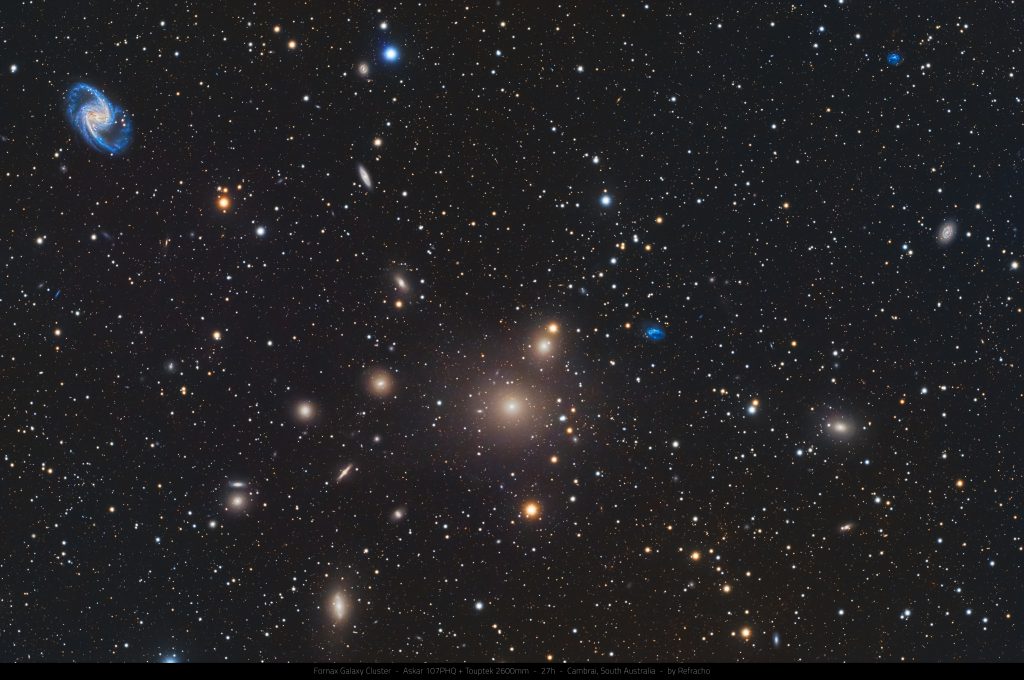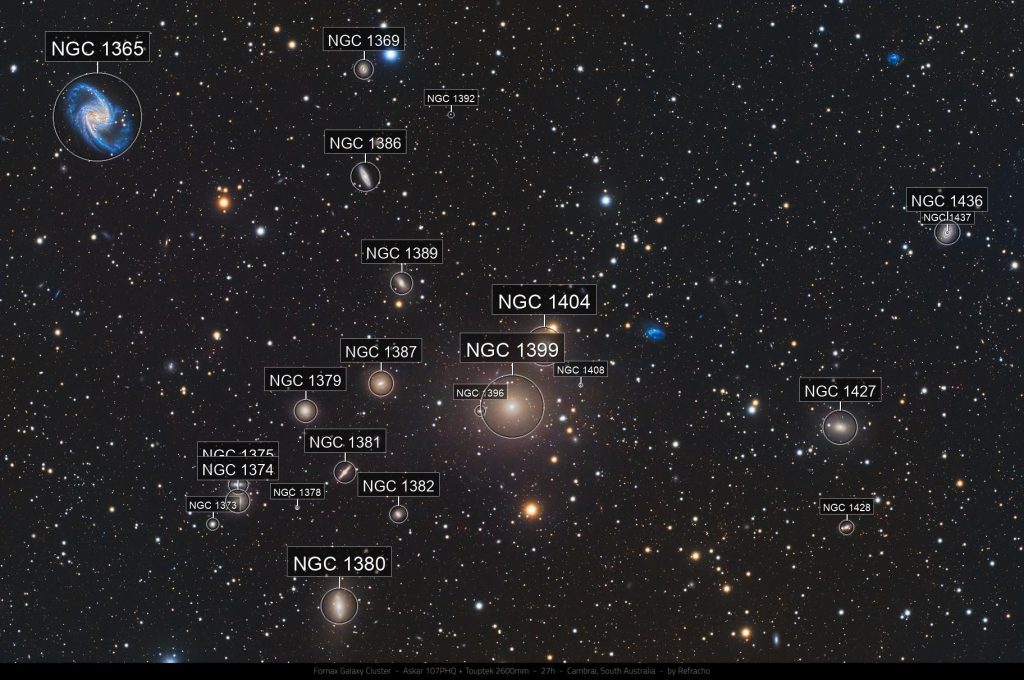Acquisition Details
- Dates: August 20, 23; September 17; October 14, 2025
- Filters & Exposure:
- Luminance: 150 × 300″ (12h 30m)
- Red: 60 × 300″ (5h)
- Green: 51 × 300″ (4h 15m)
- Blue: 60 × 300″ (5h)
- Total Integration: 26h 45m
- Moon Conditions: Avg. Moon age 17.2 days, phase 17%
- Imaging Parameters:
- RA center: 03h 38m 29s
- DEC center: −35° 36′ 32″
- Pixel scale: 1.47″/pixel
- Orientation: 179.69°
- Field radius: 1.62°
- Location: Meldanda, Cambrai (South Australia)


Introduction
Located around 62 million light-years away in the southern constellation Fornax, the Fornax Galaxy Cluster is one of the nearest and most compact galaxy clusters to our Local Group.
Its luminous heart, dominated by the giant elliptical galaxy NGC 1399, anchors a rich environment of smaller ellipticals and lenticulars. On the outskirts lies the stunning barred spiral NGC 1365, whose delicate arms contrast beautifully against the dense galactic core region.
This deep LRGB integration reveals dozens of galaxies scattered across the frame. Each faint smudge of light represents an entire island universe, quietly rotating in the vast cosmic ocean — a humbling reminder of the immensity of space.
Processing and Challenges
The main challenge in processing this dataset was the extreme dynamic range between the bright galactic cores — especially NGC 1399 — and the surrounding faint halos.
A standard nonlinear stretch easily led to clipped cores, erasing internal structure and creating unnatural transitions. To restore those inner details while retaining the faint outer glow, I applied HDRMultiscaleTransform (HDRMT) in PixInsight to carefully compress the brightness range.
Using HDRMultiscaleTransform (HDRMT) in PixInsight
The HDRMT process is designed to compress high dynamic range structures across multiple scales. It’s ideal for bright galaxy cores, nebular centers, and globular clusters where intensity differences are significant.
Step 1 – Create a Local Mask
- Use RangeSelection to isolate the bright galaxy cores.
- Optionally blend with a StarMask to protect stars (
rangeMask * ~starMask). - Invert the mask if needed, so only the bright cores receive HDRMT.
- Slightly blur the mask edges (2–3 px) to avoid sharp transitions.
Step 2 – Apply HDRMT on the Luminance Channel
- Check:
To Lightness✅ - Do not check:
Preserve hue - Number of Layers: 5–8 (more layers = stronger compression)
- Iterations: 1–2 gentle passes instead of one heavy compression
- Deringing: enable if you notice halos or dark rims
Result: the galaxy cores regain smooth gradients while faint halos remain intact.
Step 3 – Apply HDRMT on the RGB Image (Optional)
- Check:
Preserve hue✅ (maintains color balance) - Do not check:
To Lightness - Number of Layers: 4–6, mild strength
This optional step evens out any remaining overexposure in the color rendition without distorting hues.
Step 4 – Refine Local Contrast
After HDRMT, use LocalHistogramEqualization (LHE) with small kernels (40–80) and a gentle amount (0.2–0.35) to bring back subtle structures.
A mild CurvesTransformation (S-curve on L only) can enhance contrast if needed — but avoid re-blowing the cores.
Notes & Tips
- Never enable both To Lightness and Preserve hue simultaneously; use one depending on whether you’re processing L or RGB.
- If halos or inverse edges appear, soften the mask and reduce the number of layers.
- Typical workflow:
Linear Noise Reduction → Deconvolution (L) → Stretch → HDRMT (L) → Combine RGB → HDRMT (RGB, optional) → LHE/Curves finishing
Through careful HDRMT application, the bright ellipticals like NGC 1399 and NGC 1387 display smooth luminosity transitions while their extended halos remain visible, resulting in a balanced and natural look.
Final Remarks
Though less famous than Virgo, the Fornax Cluster offers a rich and varied field — from smooth ellipticals to striking spiral forms, all within a single frame.
With nearly 27 hours of total integration, this dataset captures not just light, but time itself — photons that began their journey over 62 million years ago, now converging onto a single sensor in the quiet darkness of South Australia.